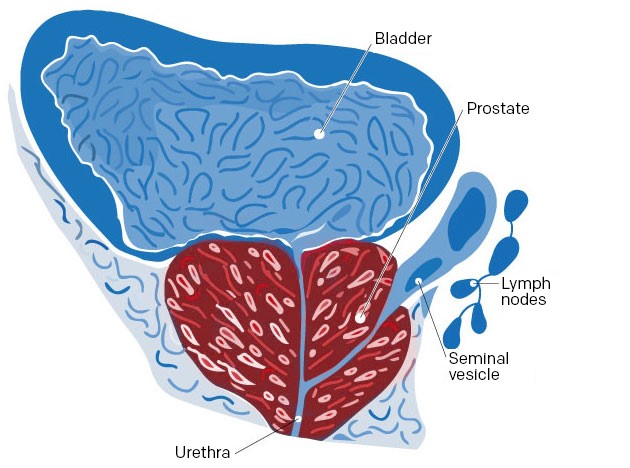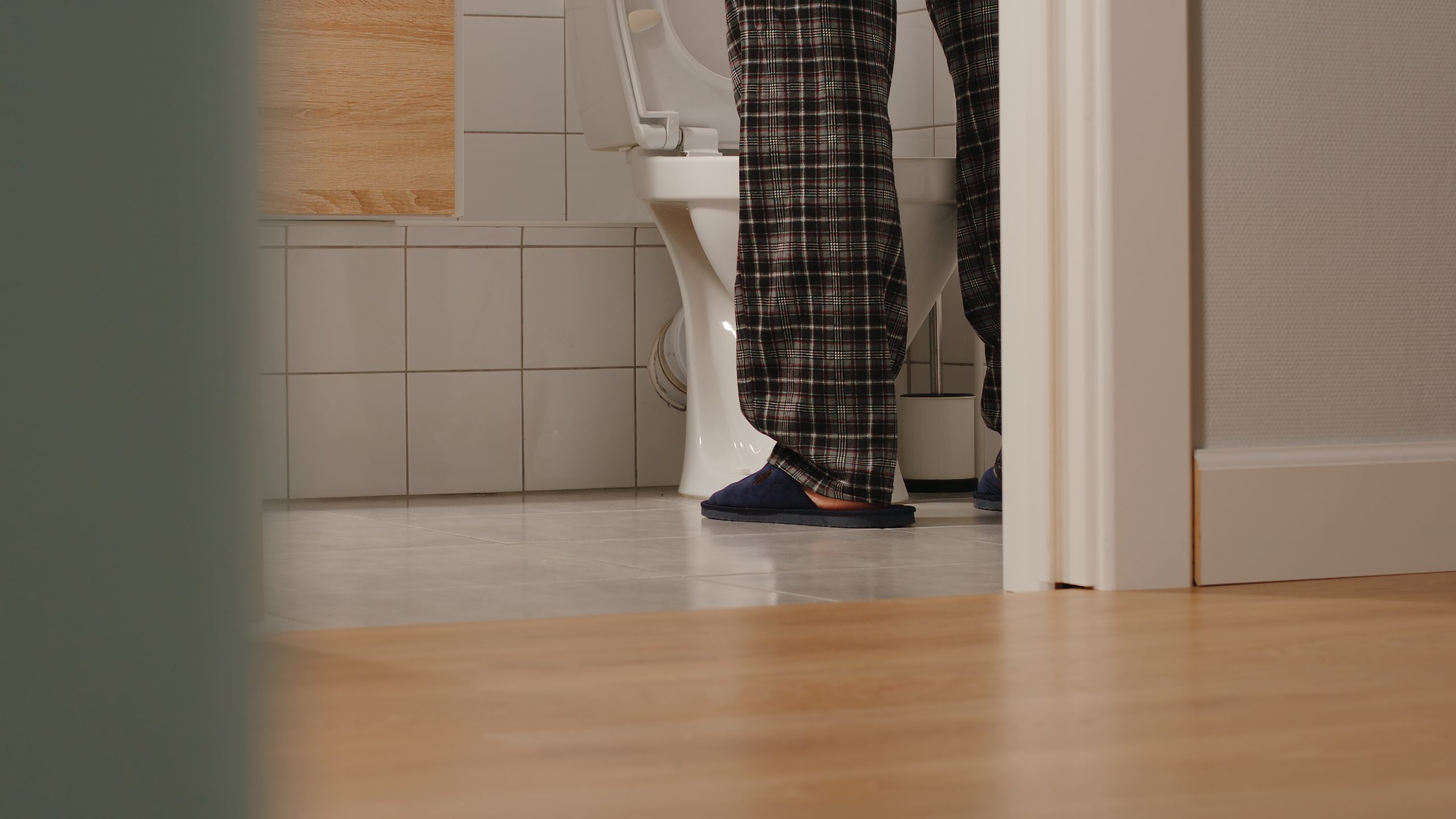Signs and symptoms
Signs and symptoms
A “silent” cancer
Most often, prostate cancer does not present any symptoms; it is said to be “silent.” It will be discovered by chance, following a blood test or during a routine prostate examination. Hence the importance of screening in middle-aged men.
In some cases, urinary symptoms may appear when the tumor grows and puts pressure on the urethra or when it is advanced. Other medical conditions can cause similar symptoms such as prostatitis or benign prostatic hyperplasia (BPH).
Get more information about potential warning signs on this page. If you have any questions or concerns, feel free to contact us at 1-855-899-2873 or via chat to speak with one of our healthcare professionals.specialized in uro-oncology.
Similar symptoms when the urethra is compressed
Symptoms begin to appear as the tumor increases and puts pressure on the urethra or when as the cancer advances. The symptoms are the same as for benign prostatic hypertrophy (BPH) because as the prostate grows older it increases in volume and compresses the urethra. Prostatitis can also cause symptoms similar to prostate cancer. However, as mentioned earlier, the majority of patients with prostate cancer will have no clinical symptoms.
After the age of 40, it is important that men make sure not to confuse BPH, prostatitis and prostate cancer. BPH and prostatitis do not equate to prostate cancer. They are among the most common prostate-related conditions. Therefore, a medical examination becomes more than important to clear up any doubts.
Tests your doctor will administer based on signs and symptoms
If you have any unusual symptoms, it is important to consult your doctor to determine its cause. The doctor may then suggest you undergo a prostate-specific antigen (PSA) blood test and a rectal exam.
If your doctor believes that further tests are necessary to confirm or rule out a prostate disorder, he will refer you to a urologist. The urologist may repeat some of the tests you have already undergone. You may be asked to undergo another PSA test in the near future to check if your PSA level is increasing over time and/or to confirm a temporary increase. Based on the results, you will decide together on the next steps.

The most common signs and symptoms
n the early stages of BPH, there are no signs and symptoms. These appear when the enlarged prostate exerts pressure on the urethra and bladder. This can reduce the diameter of the urethra (compressing it) or irritating the bladder, which can cause changes in urinary habits and difficulty urinating. In some patients, symptoms may appear with minimal enlargement of the prostate.
BPH can cause the following symptoms:
- A frequent need to urinate during the day and night (frequent urination)
- An urgent need to urinate
- Difficulty starting or stopping urination
- A weak or slow urine stream
- An interrupted urine stream
- A sensation of incomplete emptying of the bladder
- Difficulty controlling the bladder (urinary leakage)
- Pain or burning sensation when urinating
- Difficult or painful ejaculation
- Presence of blood in the urine or semen (rare)
 The most common signs and symptoms
The most common signs and symptoms
Prostatitis can cause a wide range of symptoms that vary greatly from man to man. They may be similar to those caused by benign prostatic hypertrophy (BPH) and prostate cancer. On the other hand it differ in that there is an acute pain present in the pelvic area accompanied by a high fever and chills.
Prostatitis can be caused by an acute urinary tract infection (bacterial prostatitis) or by chronic inflammation/chronic sensitivity.
Prostatitis can cause the following symptoms:
- A need to urinate often during the day and night (frequent urination)
- An urgent need to urinate
- Difficulty starting or stopping urination
- A weak or slow urine stream
- An interrupted urine stream
- A sensation of incomplete emptying of the bladder
- Pain or burning sensation when urinating
- Pain in the pelvic region (genitals, groin, lower abdomen, or lower back)
- Difficult or painful ejaculation
- Fever and chills if the prostatitis is acute
- Recurrent urinary tract infections
- Presence of blood in the urine or semen (rare)
 Signs and symptoms of a localized cancer
Signs and symptoms of a localized cancer
It is common for prostate cancer, especially in the early stages, to cause no symptoms due to its typically slow development. Symptoms may appear if the tumor grows and compresses your urethra, leading to changes in your urinary habits or other issues, or if your cancer is advanced. The tumor generally does not cause pain in the prostate itself.
But first and foremost, don’t panic! Since prostate cancer typically begins to develop in the part of the prostate closest to the rectum (the peripheral region of the prostate), it often does not press on the urethra, thus causing symptoms at an early stage.
As mentioned earlier, it is important to note that all these symptoms are usually caused by benign prostate enlargement that occurs with age and not by prostate cancer. They can also be caused by other problems related to the urinary tract, such as bacterial or infectious prostatitis, among others.
Cancer can cause the following symptoms (most often, there are no symptoms):
- A frequent need to urinate during the day and night (frequent urination)
- An urgent need to urinate
- Difficulty starting or stopping urination
- Weak or slow urine stream
- Intermittent urine flow
- Feeling of incomplete emptying of the bladder
- Difficulty controlling bladder (urinary incontinence)
- Pain or burning sensation when urinating
- Difficult or painful ejaculation
- Presence of blood in urine or semen (rare)
 Signs and symptoms when it spreads outside the prostate
Signs and symptoms when it spreads outside the prostate
After the cancer begins to grow in the prostate, it spreads to the pelvic lymph nodes. (These are not the lymph nodes in the groin, which are perceptible to the touch. The pelvic lymph nodes are located deep in the abdomen next to the prostate and cannot be seen or felt.) This is known as nodal metastasis. Nodal metastasis is not painful, although it sometimes causes edema (swelling) of the feet and ankles.
In more advanced stages of the disease, the cancerous cells usually migrate to the bones, particularly those of the pelvis and spinal column. This is known as bone metastasis.
If the metastases are large enough, the following symptoms may appear:
- Pain in the lower back or hips
- Numbness or paralysis of the lower limbs (at the spinal level, metastases can compress the spinal cord)
- Edema (swelling) of the feet and ankles (lymph node metastases can cause poor lymphatic drainage of the lower limbs
- Weight loss and general loss of condition (feeling of unwellness)
- Constant fatigue and pallor (bone metastases can cause anemia)
If initial tests, like a prostate-specific antigen (PSA) blood test or digital rectal exam, indicate potential prostate cancer, your urologist may advise a prostate biopsy. This biopsy assesses the cancer’s progression rate and helps identify the most suitable treatment options.
Additional Information - Signs and symptoms

Genetics and prostate cancer
Do you have a family history of cancer? Your doctor might recommend genetic screening.

Symptoms, risk and screening
Are you over 50 or experiencing urinary problems? Discover why early screening for prostate diseases is important.

Everything to know about male urinary incontinence
Do you suffer from male urinary incontinence? You’re not alone. This webinar covers symptoms and treatments to help you.

Male incontinence: 8 myths to dispel
Male incontinence is a taboo subject that is the subject of several myths. For those affected, having the right information is essential.

Incontinence: How to choose the right product?
Although we hear less about urinary incontinence in men, some of them are faced with this urological problem.

BPH: Myths and Reality
BPH or enlarged prostate is a natural phenomenon as we age. If you have BPH, it’s important to separate the facts from the myths.

Long live my old prostate!
Long live my old prostate that I respect! Present only in men, once adult, it can be as much a friend as naughty.

Why am I urinating my semen
If you are wondering why you urinate your semen, the answer is that you have what is called retrograde ejaculation.

Foods that irritate your bladder
Do you have urinary symptoms that affect you on a daily basis? The article Foods that irritate your bladder is for you. We know that the prescription of certain medications can promote urinary incontinence in some people. The side effects of these drugs are sometimes temporary, but it is important to talk to your doctor about them. But what about […]

10 signs that encourage you to see a doctor
There are many reasons why men will be referred to a specialist, and if you experience any of the following symptoms you should see a family doctor. Here are 10 signs that encourage you to consult. You should also know that unless you go to a private clinic, you cannot consult a specialist directly, such as […]

I think it’s a urinary tract infection
Do you have urinary symptoms accompanied by pain or burning when you urinate? It could be a urinary tract infection. UTI is much rarer in men than in women. It has two major causes: a sexually transmitted disease or complications related to your prostate. Infection can happen when harmful bacteria lodges in your urinary tract. […]

My bladder is full and I am no longer urinating!
A sudden and painful inability to voluntarily empty the bladder suggests acute urinary retention. My bladder is full and I am no longer urinating means consult urgently! It is more common in men than women and is most often due to an enlarged prostate or BPH. The latter can compress the urethra, to the point […]
Sources and references
Last medical and editorial review: April 2024. See our web page validation committee and our collaborators by clicking here.

